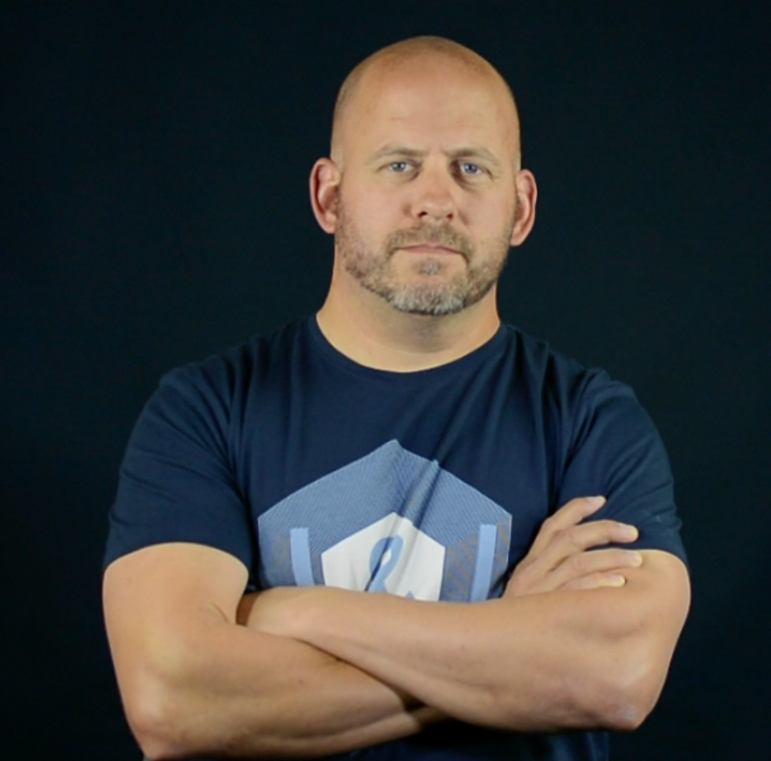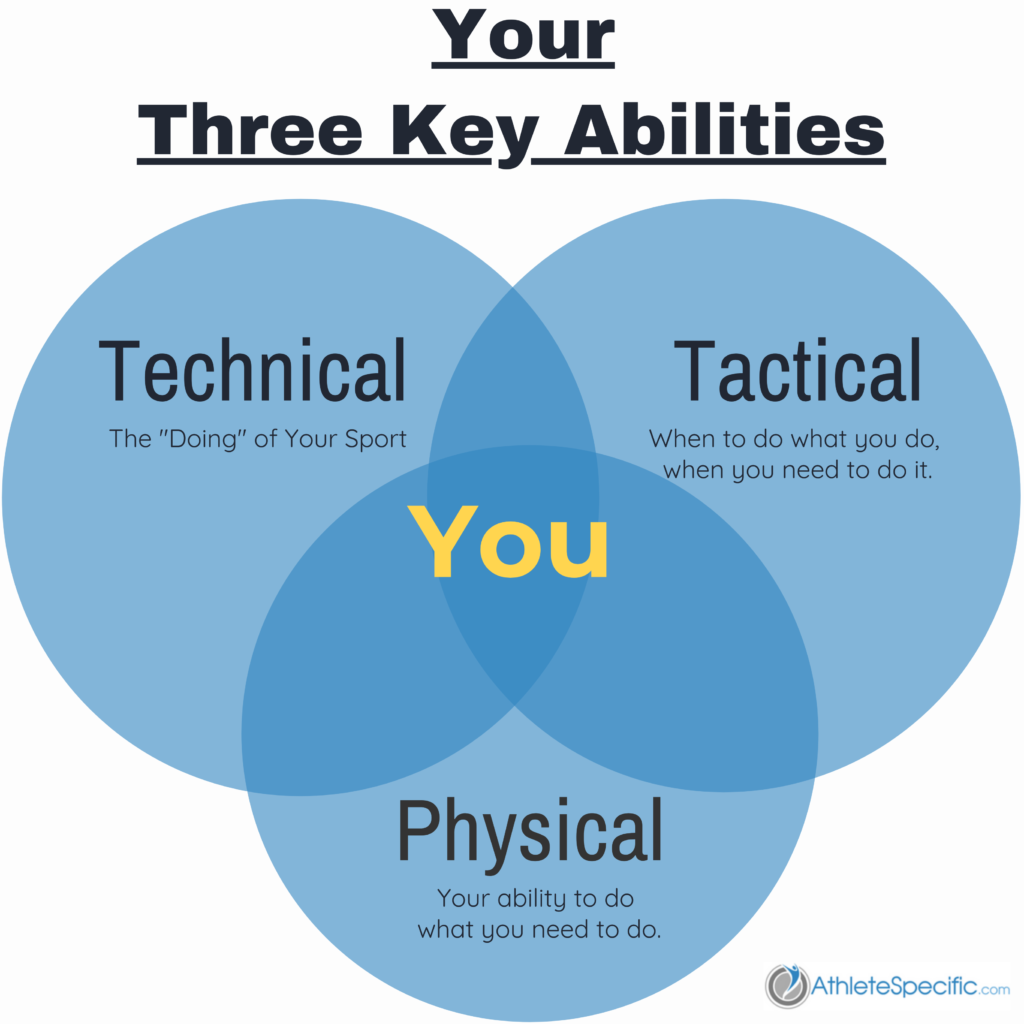Three Key Abilities: Every athlete is made up of three Key Abilities. The best athletes have developed all three sufficiently. Young or new athletes can get by on just two, and sometimes even just one! But to have success long term in your sport you’re going to need all three.
My athletes understand that they can’t get stuck working on just one of their Three Key Abilities, but that’s what most athletes do. And eventually, they get passed over by athletes who are working on all three.
You may have seen these Three Key Abilities listed before, but not like I’m about to show them to you now. It’s a common mistake, but the understanding you have of The Three Key Abilities will help skyrocket an athlete’s athletic performance AND their results.
The Three Key Abilities
Every athlete has a Physical Ability, a Technical Ability, and a Tactical Ability. Those are the three abilities. The mistake that is made when these Abilities are taught is that they are taught like they are three legs on a stool. The idea is if you take one of the legs away, the stool will tip over.
That’s not how I teach them. You’re not going to tip over if you’re missing one of these. You’re just going to have to compensate in one of the other Abilities to be enough of an athlete to compete.
I view an athletes Three Key Abilities like this:
I’m going to start by describing an athlete’s Technical Ability and you’ll see just how this all fits together.
Technical Ability
This is what I call, “The DOING of the thing.”
Technical Ability: The DOING of the thing you need to do.
If we have a tennis player, their Technical Ability is striking the ball with a racquet, while a hockey player has the act of shooting and receiving pucks AND the Technical Ability of skating on the ice. A quarterback has the Technical Ability of throwing a football. A gymnast has the Technical Ability of balancing and jumping and twisting and tumbling.
These are all Technical Abilities, and for many athletes it’s the part of their sport they like to do the most. (I’ll explain why that can hurt their development in a moment.)
Physical Ability
This can seem pretty obvious, but an athlete’s Physical Ability is an athletes ability to do what it is he or she needs to do. Using lacrosse as an example an athlete has the Technical Ability to throw and catch the ball, but if we lop their arm off, that’s going to affect their Physical Ability.
Physical Ability: The ability to do, what it is you need to do.
As morose as that may sound, let’s use some other examples…
If I say, “Jump” an athlete uses his or her Physical Ability to jump. If I say run, they run. An athlete’s body can either do it, or it can’t. An athlete may be able to run but they may run slow. If an athlete is injured, their Physical Ability takes a toll.
The Physical Ability is probably the easiest ability to improve. When athlete’s come to us for Strength and Conditioning programming it is their Physical Ability that they want to improve. I call it, “Giving Mother Nature a kick in the butt.” Athletes who develop their Physical Ability at a young age tend to overwhelm their same-age peers because they are either bigger, faster, or stronger. This causes them to run faster, jump higher, and move around quicker giving them an advantage.
Tactical Ability
Tactical Ability is an athletes ability to do what it is they need to do, when they need to do it.
Tactical Ability: Your ability to do WHAT it is you need to do WHEN you need to do it.
This is where a football player can be told to run ten yards, cut left, and then cut right into the end zone. Those are tactics. The same goes for a set play in ice hockey or lacrosse.
In a sport like gymnastics or figure skating, Tactical Ability decisions are made in choreography where a coach might say, “Ok, we need to be able to do this jump, and this combination, and these “Twizzles” (Yes, Twizzles are a thing.”
Tactical Ability also comes into play OFF the field of play. Deciding to go for a tryout, or play for a new team or coach, or to move across the country to train in a difference gym, those are all “tactical” decision.
How The Three Key Abilities Fit Together
As I mentioned in the introduction some athletes can get by on two of the three, and sometimes even one! I worked with a hockey player who was so advanced physically at the age of fifteen he literally skated through kids and could shoot the puck like a cannon.
Athletes who are small and physically less advanced tend to get really good technically and tactically because they need to make up for their physical limitations. Slow and/or small kids develop fast hands. They may be small but quick. Or they develop their Tactical Abilities so they don’t get hit or hurt.
Prodigious athletes like a Coco Gauff or a Mikaela Shiffrin have a combination of advanced Physical, Technical and Tactical Abilities at a young age. Even though their Chronological Age (when they were born) might be young, their Biological Age is advanced which gives them the advantage to try new technical skills and learn advanced tactics earlier than their age group peers.
Why Comparison With Patience Is Key
Man of the athletes I work with in our Breakthrough Blueprint Program are either advanced in some abilities and/or deficient in others. When they compare themselves they can get quite negative when they see athletes who are the same age (or younger) who are better than them.
This is where patience is key. It’s natural to compare yourself to other athletes. It’s what competition is all about. But comparing yourself to an outlier who is unusually physically, technically or tactically advanced can put an athlete in a negative spiral.
Sure, we’d all like to be winning and getting recruited at young ages, but it’s rare.
And the great news is that athletes who have to develop their Tecnical and Tactical Abilities to overcome Physical Ability deficiency, tend to outpeform those early growers later in their careers.
That’s why patience is really important. If the athlete is 5’6″ but mom and dad are both over 5’10” there’s a lot of hope that they will get that height later. They may want it now, but Mother Nature has other plans.
If the athlete has the dream, and can have some patience, they will win in the long run and that’s what counts the most.
Join Me In Our Next Post
In our next blog post, I’m going to talk about how athletes can get too comfortable working on one, and maybe two, of their Three Key Abilities and why that can set them up for failure. Until then, please share this with an athlete who needs to see it and/or their parent or coach. Any questions…don’t hesitate to ask and please leave a comment below.

Olympian Jonathan Edwards
Founder - The Athlete Breakthrough Blueprint
Olympian Jonathan Edwards is the Creator of "The Athlete Breakthrough Blueprint": The world's only mental performance training program for aspiring athletes with big dreams. Over nineteen years he has worked with athletes who have gone on to or competed in NCAA D1, D2, D3, MCLA D1 and D2, the Olympics, NHL, MLL, NLL, NFL, and others. Feel free to link to this article from your blog and share it with an athlete, parent, or coach who would benefit from these concepts.


